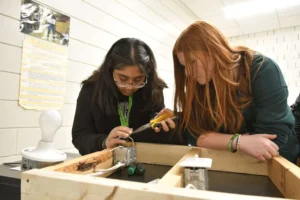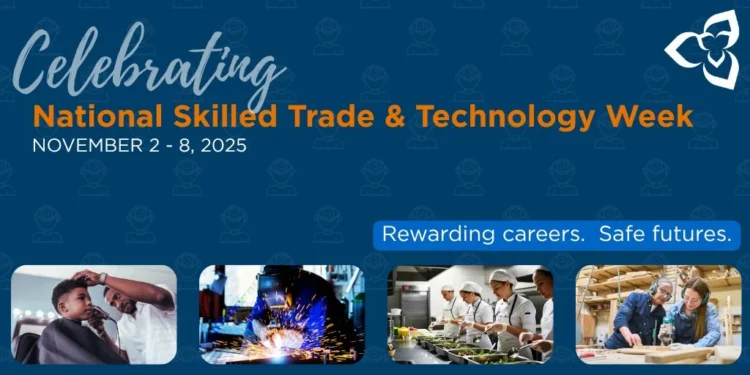Across Canada, classrooms and workshops came alive from 2 to 8 November 2025 as National Skilled Trade and Technology Week (NSTTW) returned for its 21st edition. At Centennial College in Toronto, hundreds of students spent the day welding, coding, and testing robotic arms under the same roof. The event, hosted by Skills/Compétences Canada and its partners, was equal parts career fair and experiment in the country’s future labour mix.
The timing couldn’t be sharper. According to a Government of Canada report and RBC Economics analysis, about 700,000 skilled-trade workers are expected to retire between 2019 and 2028 — a talent gap that threatens everything from housing construction to clean-tech manufacturing. NSTTW’s organisers see technology as the bridge: by connecting digital tools with traditional trades, Canada hopes to turn an impending shortage into an innovation opportunity.
What NSTTW Is and Why It Matters Now

NSTTW is Canada’s national campaign to promote careers in skilled trades and technology. Led by Skills/Compétences Canada and supported by its provincial and territorial chapters, the week links industry, education, and government through “Try-A-Trade & Technology” activities, school visits, and public showcases.
The 2025 edition leaned heavily into the overlap between trades and tech. Students explored virtual-reality welding simulators, renewable-energy demos, and AI-enabled design tools that mirror the modern job site. Behind the fanfare sits a larger message: trades have evolved faster than public perception. The same digital skills driving app development now run the machines, systems, and data platforms that keep Canada’s economy moving.
Where Technology and Trades Intersect
If there was one takeaway from NSTTW 2025, it’s that the line between trades and tech is vanishing. At Centennial College, students tried their hands at everything from virtual-reality welding to 3D design software used in advanced manufacturing. Elsewhere, Skills/Compétences Canada hosted demonstrations in robotics, renewable energy systems, and automation, showing how technology now drives productivity in fields once thought purely manual.
Today’s mechanics use diagnostics software as often as wrenches. Electricians rely on sensors and smart grids. Construction professionals use drones and digital twins to track project progress in real time. Even plumbers are learning to install water systems embedded with IoT sensors. These aren’t separate worlds anymore. The modern trade is a digital trade.
For educators, this shift demands a rethink of how vocational programs are designed. Technical colleges are now blending traditional apprenticeship training with modules in data analytics, AI safety, and computer-aided design. NSTTW put that integration on display, proving that Canada’s skills agenda is no longer just about filling labour gaps but preparing a tech-competent workforce for a digitised economy.
Why Businesses Are Paying Attention
Canada’s industries are watching closely. Employers across construction, energy, and advanced manufacturing see the same challenge: the tools of their trades are evolving faster than their talent pipelines. Many are turning to partnerships with colleges and trade organisations to close that gap.
Skills/Compétences Canada, backed by corporate sponsors such as Canadian Tire, Samsung Electronics Canada, and TransCanada, is helping companies connect directly with students through co-ops and on-site training. These collaborations expose young workers to the digital platforms already transforming job sites.
Industry leaders argue that building Canada’s green and digital economy will depend on people who can combine physical skill with technical fluency. As automation spreads, businesses need workers who can both operate and optimise machines. That dual competency, the ability to work with tools and tech, is quickly becoming Canada’s most valuable skill set.
The Students Behind the Shift
At the Centennial College showcase, the excitement felt different this year. Students huddled around welding simulators and digital drafting screens, moving easily between hands-on work and high-tech interfaces. Some explored 3D game art and animation; others tested electrical circuits, renewable-energy rigs, or robotics systems. The boundaries between creative tech, engineering, and the trades had dissolved into a single, buzzing workshop floor.

What stood out was how naturally young people navigated both worlds. Many already think in hybrid terms, the welder who edits drone footage of his project, the carpenter who learns design software to pitch clients, the mechanic who runs a TikTok channel explaining EV repairs. For this generation, digital tools aren’t separate from trades; they’re part of the toolkit.
That blend of creativity and practicality is what NSTTW hopes to nurture. Organisers see the week as more than a campaign. It’s a signal that the next wave of Canadian innovators could emerge from college workshops as easily as from coding bootcamps.
Building the Hybrid Workforce Canada Needs
NSTTW 2025 reinforced a simple truth, that the future of work isn’t divided between white-collar and blue-collar. It’s connected by technology. Canada’s ability to stay competitive, in manufacturing, construction, green energy, and digital services, depends on workers who can move fluidly between hardware and software.
The challenge now is scale. Integrating tech literacy into every trade program requires policy alignment, sustained funding, and industry mentorship. But the model is there. If each province follows the momentum from this year’s events, Canada could develop a new kind of labour force, one fluent in both tools and code.
NSTTW 2025 reframed trades. In a decade defined by automation and AI, the nation’s progress may rest not on choosing between trades and technology, but on mastering both.










